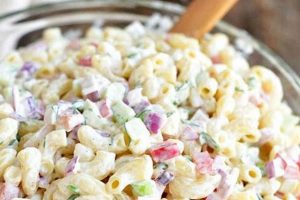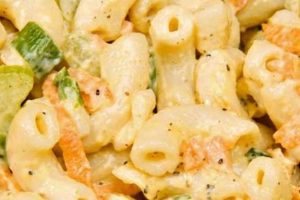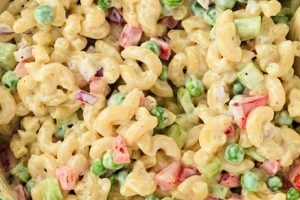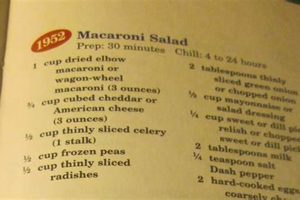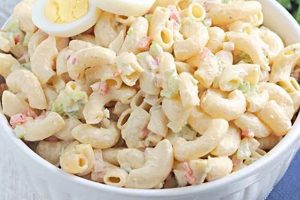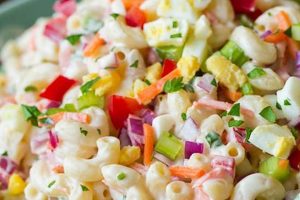Classic elbow macaroni, combined with mayonnaise and a variety of complementary ingredients, forms the foundation of this popular dish. Typical additions include chopped vegetables such as celery, onion, and bell peppers, along with hard-boiled eggs, pickles, and sometimes shredded carrots or peas. Variations can incorporate different pasta shapes, cheeses, proteins like tuna or chicken, and flavorful seasonings ranging from simple salt and pepper to prepared mustard, paprika, or garlic powder.
This dish offers a convenient and versatile option for picnics, potlucks, and barbecues due to its make-ahead nature and ability to be served chilled. Its creamy texture and customizable flavor profile contribute to its widespread appeal. Historically, macaroni salads gained popularity in the early 20th century as refrigeration became more common, enabling safe preparation and storage of mayonnaise-based dishes. This accessibility, combined with the affordability and availability of ingredients, cemented its place as a staple in many cuisines.
Further exploration will delve into specific ingredient combinations, preparation techniques, tips for achieving optimal texture and flavor, and suggestions for variations that cater to diverse dietary preferences and needs.
Tips for Exceptional Macaroni Salad
Achieving a well-balanced and flavorful macaroni salad requires attention to detail throughout the preparation process. These tips offer guidance for optimizing texture, flavor, and overall quality.
Tip 1: Cook Pasta Al Dente: Slightly firm pasta holds its shape better in the salad and prevents a mushy texture. Cook pasta according to package directions, reducing the cooking time by a minute or two for optimal firmness.
Tip 2: Rinse Cooked Pasta Thoroughly: Rinsing removes excess starch, preventing the pasta from sticking together and creating a cleaner flavor profile.
Tip 3: Chill Ingredients Before Combining: Using chilled pasta and other ingredients helps maintain food safety and prevents the mayonnaise from breaking down.
Tip 4: Balance Flavors with Acidity: Incorporating acidic elements like vinegar, lemon juice, or pickle relish enhances the overall flavor profile and cuts through the richness of the mayonnaise.
Tip 5: Season Gradually and Taste Frequently: Start with a small amount of seasoning and adjust to taste as needed. This prevents over-seasoning and allows for customized flavor development.
Tip 6: Don’t Overmix: Gentle mixing prevents the ingredients from breaking down and maintains a desirable texture.
Tip 7: Chill Before Serving: Allowing the salad to chill for at least an hour allows the flavors to meld and enhances the overall experience.
Following these guidelines ensures a delicious and satisfying macaroni salad experience. Attention to these details elevates the dish from simple to exceptional.
By incorporating these tips, one can consistently create a macaroni salad that is both visually appealing and flavorful. The following section concludes with final recommendations and variations.
1. Classic Creamy Texture
The classic creamy texture is a defining characteristic of macaroni salad made with mayonnaise. This texture, derived primarily from the emulsification of oil and egg yolks in mayonnaise, contributes significantly to the dish’s overall sensory appeal and perceived quality. Understanding the factors influencing this texture allows for greater control over the final product.
- Mayonnaise Quality
The type and quality of mayonnaise used directly impact the final texture. Higher-quality mayonnaise, typically containing a greater proportion of oil and egg yolks, yields a richer, creamier texture. Lower-quality mayonnaise, often containing more water and starches, may result in a thinner, less desirable consistency. Selecting a mayonnaise with a smooth, stable emulsion is crucial for achieving the desired creaminess.
- Ingredient Ratios
The balance between mayonnaise and other ingredients significantly affects the texture. Too much mayonnaise can create an overly rich and heavy salad, while too little can result in a dry, less appealing dish. Careful consideration of ingredient proportions is essential for achieving the ideal balance of creaminess and other textural elements.
- Pasta Shape and Cooking Time
The shape of the pasta and its cooking time influence the texture. Small, tubular pasta shapes like elbow macaroni hold the creamy dressing well. Overcooked pasta absorbs more dressing, potentially leading to a mushy texture. Cooking pasta al dente helps maintain its structural integrity and allows it to retain its shape within the salad.
- Temperature and Chilling Time
Temperature plays a role in the perceived creaminess. Cold temperatures firm up the mayonnaise, enhancing the creamy texture. Chilling the salad for a sufficient period allows the flavors to meld and the texture to stabilize, resulting in a more cohesive and enjoyable sensory experience.
These interconnected factors contribute to the classic creamy texture expected in macaroni salad prepared with mayonnaise. Manipulating these variables allows for customization and optimization of the texture, leading to a more satisfying culinary outcome. Understanding these elements empowers one to create a macaroni salad that not only tastes delicious but also offers a pleasing textural experience.
2. Versatile Ingredient Combinations
The adaptability of macaroni salad recipes featuring mayonnaise lies in the wide array of ingredients that can be incorporated. This versatility allows for customization based on personal preferences, dietary needs, and seasonal ingredient availability. Exploring these ingredient combinations reveals the potential for creative expression and flavor exploration within this seemingly simple dish.
- Vegetables
A variety of vegetables contribute textural and flavor complexity. Common choices include celery, onion, and bell peppers, offering crispness and a mild vegetal sweetness. Other options such as chopped carrots, shredded cabbage, or blanched peas introduce different textures and flavor profiles. Seasonal variations might incorporate fresh corn kernels in the summer or roasted root vegetables in the fall. The choice of vegetables influences not only the flavor but also the visual appeal of the salad.
- Proteins
While often considered a side dish, incorporating protein transforms macaroni salad into a more substantial meal. Classic additions include hard-boiled eggs, offering a creamy texture and protein boost. Canned tuna or shredded chicken provide heartier options. Other possibilities include cooked shrimp, diced ham, or crumbled bacon, each adding distinct flavors and textures. The choice of protein significantly impacts the overall nutritional profile and culinary experience.
- Flavor Enhancers
Flavor enhancers elevate the taste profile beyond the basic mayonnaise and vegetable combination. Common additions include sweet pickle relish, dill pickle relish, or chopped pickles, offering tangy and savory notes. Fresh herbs like dill, parsley, or chives contribute brightness and aromatic complexity. Spices such as paprika, mustard powder, or garlic powder add depth and warmth. These elements contribute significantly to the overall flavor balance and complexity of the salad.
- Mix-ins and Garnishes
Beyond core ingredients, mix-ins and garnishes provide further opportunities for customization. Chopped olives, crumbled blue cheese, or shredded cheddar cheese introduce salty and savory elements. Toasted nuts or seeds add crunch and nutty notes. Garnishes like paprika, chopped fresh herbs, or a sprinkle of black pepper enhance visual appeal and provide subtle flavor nuances. These additions contribute to a more refined and visually appealing presentation.
The interplay of these ingredient categories highlights the remarkable versatility of macaroni salad recipes with mayonnaise. The careful selection and combination of vegetables, proteins, flavor enhancers, and mix-ins allow for a wide spectrum of flavor profiles and textures. This adaptability ensures that macaroni salad remains a relevant and customizable dish, suitable for a variety of occasions and palates.
3. Simple, Quick Preparation
The ease and speed of preparation contribute significantly to the popularity of macaroni salad recipes featuring mayonnaise. This characteristic makes the dish accessible to a broad range of individuals, regardless of culinary skill level. Examining the components of this simplicity reveals its practical advantages and explains its enduring appeal.
- Minimal Cooking Required
The primary cooking task involves boiling the pasta, a straightforward process requiring minimal culinary expertise. Most other ingredients require no cooking, such as chopping vegetables, dicing hard-boiled eggs, or opening a can of tuna. This minimal cooking requirement reduces preparation time and simplifies the overall process, making it an attractive option for quick meals or situations where extensive cooking is impractical.
- Commonly Available Ingredients
Recipes typically utilize readily available ingredients found in most grocery stores. Mayonnaise, pasta, and common vegetables like celery, onions, and peppers are staples in many households. This accessibility eliminates the need for specialized ingredients or extensive shopping trips, further streamlining the preparation process.
- Adaptability to Variations
The simplicity of the base recipe allows for easy customization without adding significant complexity. Substituting different pasta shapes, adding various proteins, or incorporating preferred vegetables does not drastically alter the preparation time or difficulty. This adaptability makes the dish versatile and accommodating to individual preferences and dietary needs.
- Make-Ahead Convenience
Macaroni salad can be prepared in advance and stored in the refrigerator, allowing flavors to meld and enhancing the overall experience. This make-ahead convenience is particularly beneficial for potlucks, picnics, or busy weeknight meals where time is limited. Preparing the salad ahead reduces stress and allows for efficient time management.
The combination of minimal cooking, readily available ingredients, adaptability, and make-ahead convenience contributes to the simple and quick preparation associated with macaroni salad recipes using mayonnaise. These factors collectively enhance the dish’s practicality and appeal, making it a convenient and satisfying option for various occasions and culinary skill levels.
4. Ideal for Various Occasions
The suitability of macaroni salad recipes featuring mayonnaise for a broad range of occasions stems from a confluence of factors, including its adaptability, transportability, and generally accepted appeal. These characteristics make it a practical and versatile dish for social gatherings, casual meals, and holiday celebrations alike.
The adaptability of macaroni salad manifests in its ability to complement diverse menus. It functions equally well as a side dish alongside grilled meats, fried chicken, or sandwiches. Its neutral flavor profile does not clash with stronger flavors, making it a compatible accompaniment to various cuisines. Furthermore, the customizability of the ingredients allows for tailoring to specific preferences or dietary restrictions. For instance, vegetarian versions can omit meat and incorporate plant-based proteins or additional vegetables, while those seeking lighter options can opt for reduced-fat mayonnaise or incorporate more fresh vegetables. This adaptability extends to portioning; it can be served as individual portions in small containers or as a larger centerpiece dish for sharing.
Transportability contributes significantly to the suitability of macaroni salad for various occasions. Its relatively stable nature at room temperature for limited periods makes it a convenient choice for picnics, potlucks, and outdoor gatherings where immediate refrigeration might not be available. Furthermore, its ability to be prepared in advance and stored in airtight containers simplifies logistics for larger events or gatherings where on-site cooking is impractical. This transportability eliminates the need for last-minute preparation, reducing stress and enhancing convenience.
The general acceptance and widespread appeal of macaroni salad contribute to its suitability for diverse social settings. Its familiar flavors and textures are typically well-received by a broad range of palates, making it a safe and reliable choice for gatherings with diverse tastes. Its perceived comfort food status often evokes positive associations and contributes to a sense of familiarity and shared enjoyment. This general acceptance minimizes the risk of culinary clashes or exclusions, contributing to a more inclusive and harmonious dining experience.
In summary, the adaptability to diverse menus, ease of transport, and widespread appeal converge to position macaroni salad as an ideal dish for a variety of occasions. Its practicality, versatility, and generally accepted nature make it a dependable and convenient choice for social gatherings, casual meals, and holiday celebrations, ensuring broad appeal and culinary satisfaction.
5. Customization Options
Customization represents a defining characteristic of macaroni salad recipes utilizing mayonnaise. This inherent flexibility stems from the simplicity of the base recipe, which readily accommodates a wide range of ingredient substitutions and additions. This adaptability caters to diverse palates, dietary needs, and seasonal ingredient availability. The ability to personalize the dish contributes significantly to its sustained popularity and continued relevance in contemporary cuisine.
The foundational components of macaroni, mayonnaise, and a chosen selection of vegetables provide a blank canvas for culinary creativity. This allows for the incorporation of a wide array of complementary ingredients, transforming the basic concept into a personalized culinary expression. For instance, a preference for bolder flavors might lead to the inclusion of ingredients such as chopped olives, pickled jalapeos, or crumbled feta cheese. Conversely, a desire for a lighter, brighter flavor profile could result in the addition of fresh herbs like dill, mint, or parsley, alongside a squeeze of lemon juice. Dietary considerations also play a significant role; vegetarian adaptations might involve substituting chickpeas or white beans for traditional meat-based protein sources, while gluten-free versions necessitate the use of gluten-free pasta varieties. The ability to cater to these specific needs broadens the appeal and inclusivity of the dish.
The practical implications of this customization extend beyond individual preferences. Seasonal variations offer opportunities to incorporate readily available produce, enhancing both flavor and nutritional value. Summertime variations might feature fresh corn kernels, chopped tomatoes, and basil, while autumnal versions could include roasted butternut squash, dried cranberries, and pecans. This responsiveness to seasonal ingredients aligns with principles of sustainable consumption and reduces reliance on out-of-season produce. Furthermore, customization facilitates creative utilization of leftover ingredients, minimizing food waste and promoting resourcefulness in the kitchen. Ultimately, the inherent flexibility of macaroni salad recipes with mayonnaise empowers individuals to create dishes tailored to their specific tastes, dietary requirements, and available resources, reinforcing its enduring appeal and versatility in culinary practice.
6. Budget-Friendly Ingredients
Affordability often drives recipe choices, and macaroni salad recipes featuring mayonnaise consistently rank high in this regard. The dish’s budget-friendly nature stems from the accessibility and relatively low cost of its core ingredients. This allows for a satisfying and flavorful meal without significant financial investment, making it an attractive option for individuals and families seeking economical meal solutions.
- Pasta as an Economical Base
Pasta, a primary component of macaroni salad, represents a cost-effective staple food. Dried pasta varieties, particularly elbow macaroni commonly used in these recipes, are generally inexpensive and widely available. This affordability establishes a budget-friendly foundation for the dish, ensuring accessibility regardless of economic constraints. The long shelf life of dried pasta further contributes to its economical value, minimizing food waste and maximizing value per unit cost.
- Mayonnaise: A Versatile and Cost-Effective Binder
Mayonnaise serves as the binding agent and primary flavor component in macaroni salad. While variations in price and quality exist, mayonnaise generally remains a relatively affordable ingredient, especially when purchased in larger quantities. Its dual role as a binder and flavor enhancer contributes to the overall cost-effectiveness of the dish by reducing the need for additional, potentially more expensive flavoring agents.
- Affordable Vegetable Additions
Common vegetable additions to macaroni salad, such as celery, onions, and carrots, typically represent a minimal expense. These vegetables are readily available year-round and often priced competitively. The option to utilize frozen or canned vegetables, often more economical than fresh counterparts, further enhances the dish’s budget-friendly profile while maintaining essential nutrients and flavor contributions.
- Optional Protein Enhancements: Balancing Cost and Nutrition
While optional, protein additions like hard-boiled eggs or canned tuna provide nutritional value without substantial cost increases. Eggs offer a relatively inexpensive source of protein, while canned tuna provides a budget-friendly option for incorporating seafood. These additions enhance the nutritional profile of the salad while remaining consistent with the overall emphasis on affordability.
The convergence of affordable core ingredientspasta, mayonnaise, and commonly available vegetablesestablishes macaroni salad recipes featuring mayonnaise as a budget-conscious choice. Optional protein enhancements provide opportunities to increase nutritional value without significant cost implications. This inherent affordability makes the dish accessible to a wide range of individuals and families, regardless of budgetary constraints, reinforcing its value as an economical and satisfying meal option.
7. Make-Ahead Convenience
Make-ahead convenience represents a significant advantage of macaroni salad recipes featuring mayonnaise, contributing to their popularity for various occasions and busy lifestyles. This characteristic allows for efficient time management and reduces stress associated with meal preparation, particularly for events requiring advanced planning. The ability to prepare the dish in advance enhances its practicality and versatility.
- Flavor Development
Preparing macaroni salad ahead of time allows the flavors to meld and intensify. The absorption of the mayonnaise dressing by the pasta and vegetables enhances the overall flavor profile. Chilling the salad for an extended period, typically several hours or overnight, allows these flavors to deepen and harmonize, resulting in a more robust and nuanced taste experience compared to freshly prepared versions.
- Time Management and Reduced Stress
The make-ahead nature of macaroni salad reduces the burden of last-minute meal preparation. For gatherings such as potlucks, picnics, or parties, preparing the dish in advance frees up valuable time on the day of the event, allowing hosts to focus on other aspects of event planning or simply enjoy the festivities. This advantage also extends to busy weeknight meals, where time constraints often limit elaborate cooking. Having a pre-made dish readily available simplifies mealtimes and reduces stress associated with juggling multiple tasks.
- Improved Texture
The resting period after initial preparation allows the pasta to fully absorb the mayonnaise dressing, contributing to a more cohesive and desirable texture. This absorption process softens the pasta slightly, preventing a dry or overly firm texture. The chilling process further enhances the texture by firming up the mayonnaise, resulting in a creamier and more satisfying mouthfeel.
- Enhanced Food Safety
Properly storing macaroni salad in the refrigerator after preparation minimizes bacterial growth and enhances food safety. Maintaining the salad at a safe temperature below 40F (4C) inhibits the proliferation of harmful bacteria, ensuring the dish remains safe for consumption for several days. Adhering to safe food handling practices, such as using clean utensils and storing the salad in airtight containers, further contributes to minimizing food safety risks.
The convergence of flavor development, time management benefits, improved texture, and enhanced food safety underscores the value of the make-ahead convenience offered by macaroni salad recipes with mayonnaise. This attribute enhances the dish’s practicality and appeal, solidifying its position as a versatile and reliable choice for various occasions and lifestyles.
Frequently Asked Questions
This section addresses common inquiries regarding macaroni salad preparation, storage, and variations.
Question 1: What type of mayonnaise is best suited for macaroni salad?
While personal preferences vary, full-fat mayonnaise generally yields a richer, creamier texture. Reduced-fat or light mayonnaise may result in a thinner consistency. The specific brand choice depends on individual taste preferences.
Question 2: How long can macaroni salad be stored in the refrigerator?
Properly stored in an airtight container, macaroni salad typically remains safe for consumption for three to five days in the refrigerator. Beyond this timeframe, the risk of bacterial growth increases.
Question 3: Can macaroni salad be frozen?
Freezing is generally not recommended. Mayonnaise-based dressings often separate and become watery upon thawing, negatively impacting the texture and overall quality of the salad.
Question 4: How can one prevent macaroni salad from becoming too dry?
Sufficient mayonnaise is crucial for preventing dryness. Adding a small amount of milk or plain yogurt to the dressing can also enhance moisture and creaminess. Ensuring the pasta is cooked al dente prevents excessive absorption of the dressing.
Question 5: What are some suitable alternatives to traditional elbow macaroni?
Various pasta shapes work well in macaroni salad. Consider rotini, farfalle (bowtie), shells, or ditalini for textural variation and visual interest. The chosen shape should hold the dressing effectively.
Question 6: How can one adapt macaroni salad recipes for dietary restrictions, such as gluten-free or vegan diets?
Gluten-free pasta readily substitutes for traditional pasta in gluten-free versions. Vegan adaptations require replacing mayonnaise with plant-based alternatives, such as vegan mayonnaise or a cashew-based cream sauce. Ensure all other ingredients align with the specific dietary restrictions.
Addressing these common questions provides a foundational understanding of macaroni salad preparation and storage. Applying these insights allows for confident and successful preparation of this versatile dish.
This concludes the frequently asked questions section. The following section offers a collection of curated recipes for further exploration.
Macaroni Salad Recipes with Mayo
Exploration of macaroni salad recipes featuring mayonnaise reveals a dish characterized by simplicity, versatility, and enduring appeal. From its humble beginnings as a picnic staple to its continued presence on contemporary tables, this dish demonstrates adaptability through evolving ingredient combinations and persistent popularity across diverse culinary landscapes. Key factors contributing to its sustained success include the ease of preparation, affordability of ingredients, and adaptability to various occasions and dietary preferences. The creamy texture derived from mayonnaise provides a unifying element, while the customizable nature of the accompanying ingredients allows for personalized flavor profiles and creative expression within a well-established culinary framework. Understanding the interplay of these factors provides valuable insights into the dish’s enduring relevance and continued presence in culinary traditions worldwide.
The future of macaroni salad recipes with mayonnaise likely rests upon continued innovation and adaptation to evolving culinary trends. Exploration of novel flavor combinations, incorporation of diverse cultural influences, and adaptation to emerging dietary preferences will likely shape its trajectory. Continued appreciation for its inherent simplicity, affordability, and adaptability ensures its enduring presence as a versatile and satisfying culinary choice for generations to come.

